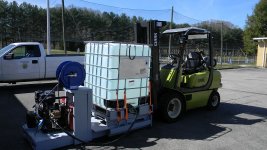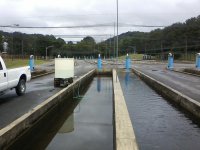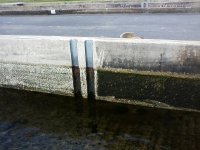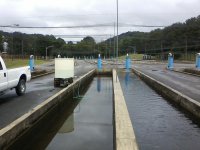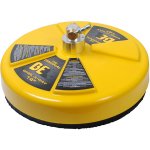I'm part of a fish hatchery crew working for the fed's (U.S. Fish and Wildlife Service). We have a need for speed in quickly prepping 8' wide x 100' long x 1.5' deep (average), concrete raceways that we clean while drained just before we put another round of trout back in them. It takes us about 30 minutes to move fish in to an empty raceway, and it takes us about 1 1/2-2 hrs to pressure wash one, depending on who is cleaning it and how bad it is algae wise. Ideally, if we could find a way, it would be great if we could pressure wash one as quickly as we could move fish to it. That way, we could have one person PWing and two people moving, which is usually about all the workers we have available at any given time.
It is very thick algae we are removing off the walls and floor, and the algae goes down the valve into a waste-water system, so we have no recovery issues and are not limited in that way. We don't go for perfection, because it is ongoing process that goes on year after year; month after month. We can't eliminate the algae, because it'll grow while fish are in them for many months at a time; we are just trying to control it so that are screens don't clog during fish hatchery operations between cycles of fish. We do not have a period of time when they are all empty. We raise fish year around and many times during the year, we'll have fish in all 104 raceways; we'll empty one out on a couple of trucks, and then we'll immediately PW it and split another raceway to it, because we'll have other raceways that have become too dense, and so we'll use that space just as soon as it becomes available.
While cleaning, we have as much as 3" of water running through them near the lower end of the raceways running down the drain, as it is impossible to stop all water flow from leaking into drained raceways that can leak through the upstream end or back through the downstream end via dam boards. This constant flow helps rinse away our work but blasting through it quickly can be difficult on the lowest 20' or so.
This is an ongoing process that is not on any kind of regular routine. In other words, we don't empty out raceways to clean them; rather it's the need to move fish around the hatchery that drives our work, and that's the priority. We have 88 of this size raceway, and we have 16 that are roughly only 4' wide. This is a year-around process as I've posted before that we cannot contract out, because we have to clean them immediately when we need them. We cannot upgrade at this time on major components or machines, but we do have some money available right now to do some minor tweaking if there is anything we could try to speed us up.
We have one 3.7 gpm/3500 psi machine and we have one 4.0 gpm/4000 psi machine; both belt driven.
We do not have a dedicated vehicle or trailer; we move our equipment, including water, via a forklift. That situation won't change any time soon, unless we can pickup a surplus 5 ton or something from another field station. We have about a quarter mile of raceways, and a city water source too far away to operate using garden hoses. We fill tanks; pressure wash till their empty; refill; and go back to the raceway(s).
Everything is going well compared to the old days when we dropped garden hoses off the side of our distribution trucks and it took much more effort and time to move equipment around the hatchery and took 3-4 hrs to pressure wash one raceway. However, I'm always looking for ways to get faster.
Looking for tips to make things faster and easier to manage...
How to set up a return line for quick connect/disconnect?
We use traditional 100' feet hoses; hose reels; but don't know how professionals properly run return lines back to tanks. Right now, our newer unit by-passes the by pass and has a return when the trigger is let off. When the unit arrived at our station, it was set up this way and would just spray out on the ground when we weren't spraying, and it even loses some water when we are spraying. I took a length of 3/8" rubber hose, stuck it on with a worm clamp and ran the hose through the top with the cap off, but what is the best way to hook up to a tank via a quick connect? We have this newer unit on a pallet and the water tank on a second stack of pallets and move them around separately around the hatchery, so we need a way to quickly disconnect and connect when setting up and moving.
How to set up a quick disconnect from the hose reel so that we can leave our 100' of hose, come back, and hook up?
Our older unit is on a platform where we move the machine and tank together around the hatchery. Overall this is better (although the supervisor doesn't think so). Sometimes we need just to fill water and keep the machine on the same raceway. In that scenario, we must first roll up the hose before we move to fill the water. Is there a way to disconnect our 100' of hose and take everything else on the forklift, fillup, come back, and reconnect the hose?
Looking for better tip options for increased speed?
We use traditional tips; usually a green tip works best. I know about the chart for the proper orifice size, but am looking to try out turbo tip or some sort of trolley or anything else that might speed us up even more. Any suggestions?
I know alot of this will be hard to visualize, but basically we fill our water tanks with an 80 gpm 2" line pumping lake water that is filtered and that takes only a couple of minutes to refill, but we have to go to the head end of our entire hatchery to do the refill. Within all this major limitations we have any advice to help with the little stuff until the time where we might be able to do some major upgrades would be helpful.
It is very thick algae we are removing off the walls and floor, and the algae goes down the valve into a waste-water system, so we have no recovery issues and are not limited in that way. We don't go for perfection, because it is ongoing process that goes on year after year; month after month. We can't eliminate the algae, because it'll grow while fish are in them for many months at a time; we are just trying to control it so that are screens don't clog during fish hatchery operations between cycles of fish. We do not have a period of time when they are all empty. We raise fish year around and many times during the year, we'll have fish in all 104 raceways; we'll empty one out on a couple of trucks, and then we'll immediately PW it and split another raceway to it, because we'll have other raceways that have become too dense, and so we'll use that space just as soon as it becomes available.
While cleaning, we have as much as 3" of water running through them near the lower end of the raceways running down the drain, as it is impossible to stop all water flow from leaking into drained raceways that can leak through the upstream end or back through the downstream end via dam boards. This constant flow helps rinse away our work but blasting through it quickly can be difficult on the lowest 20' or so.
This is an ongoing process that is not on any kind of regular routine. In other words, we don't empty out raceways to clean them; rather it's the need to move fish around the hatchery that drives our work, and that's the priority. We have 88 of this size raceway, and we have 16 that are roughly only 4' wide. This is a year-around process as I've posted before that we cannot contract out, because we have to clean them immediately when we need them. We cannot upgrade at this time on major components or machines, but we do have some money available right now to do some minor tweaking if there is anything we could try to speed us up.
We have one 3.7 gpm/3500 psi machine and we have one 4.0 gpm/4000 psi machine; both belt driven.
We do not have a dedicated vehicle or trailer; we move our equipment, including water, via a forklift. That situation won't change any time soon, unless we can pickup a surplus 5 ton or something from another field station. We have about a quarter mile of raceways, and a city water source too far away to operate using garden hoses. We fill tanks; pressure wash till their empty; refill; and go back to the raceway(s).
Everything is going well compared to the old days when we dropped garden hoses off the side of our distribution trucks and it took much more effort and time to move equipment around the hatchery and took 3-4 hrs to pressure wash one raceway. However, I'm always looking for ways to get faster.
Looking for tips to make things faster and easier to manage...
How to set up a return line for quick connect/disconnect?
We use traditional 100' feet hoses; hose reels; but don't know how professionals properly run return lines back to tanks. Right now, our newer unit by-passes the by pass and has a return when the trigger is let off. When the unit arrived at our station, it was set up this way and would just spray out on the ground when we weren't spraying, and it even loses some water when we are spraying. I took a length of 3/8" rubber hose, stuck it on with a worm clamp and ran the hose through the top with the cap off, but what is the best way to hook up to a tank via a quick connect? We have this newer unit on a pallet and the water tank on a second stack of pallets and move them around separately around the hatchery, so we need a way to quickly disconnect and connect when setting up and moving.
How to set up a quick disconnect from the hose reel so that we can leave our 100' of hose, come back, and hook up?
Our older unit is on a platform where we move the machine and tank together around the hatchery. Overall this is better (although the supervisor doesn't think so). Sometimes we need just to fill water and keep the machine on the same raceway. In that scenario, we must first roll up the hose before we move to fill the water. Is there a way to disconnect our 100' of hose and take everything else on the forklift, fillup, come back, and reconnect the hose?
Looking for better tip options for increased speed?
We use traditional tips; usually a green tip works best. I know about the chart for the proper orifice size, but am looking to try out turbo tip or some sort of trolley or anything else that might speed us up even more. Any suggestions?
I know alot of this will be hard to visualize, but basically we fill our water tanks with an 80 gpm 2" line pumping lake water that is filtered and that takes only a couple of minutes to refill, but we have to go to the head end of our entire hatchery to do the refill. Within all this major limitations we have any advice to help with the little stuff until the time where we might be able to do some major upgrades would be helpful.


